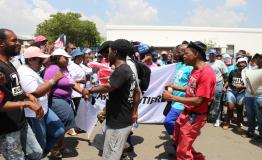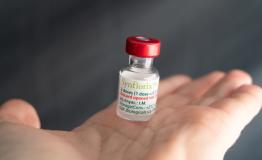

Yemen
The conflict in Yemen showed no sign of abating, despite the rampant spread of COVID-19 in the country. More people than ever before were left without healthcare, as many of the last parts of the already crippled healthcare system stopped functioning during the outbreak.
Restrictions by the local authorities on the work of aid organisations complicated our work, and healthcare facilities and workers continued to be attacked. Many civilians were killed or injured in shelling, air raids or shootings. Despite these challenges, Doctors Without Borders (MSF) continued to run 12 hospitals and health centres, and support 13 others in 13 governorates across the country.

250,300
250,3
84,600
84,6
26,600
26,6
23,400
23,4
COVID-19
The potential for COVID-19 to devastate Yemen was evident from the beginning of the pandemic: a country fragmented by fighting, with a collapsed health system and a population too poor to simply stop working and stay at home. There was also a widespread reluctance to believe that the virus was real or a threat to Yemen.
We immediately began working with the health authorities across the country. We supported Al-Amal hospital in Aden and Al-Kuwait hospital in Sana’a, the main treatment centres in the two biggest cities. We also opened smaller treatment centres in Ibb, Haydan, and Khamir, and assisted screening in Abs and Hajjah.
In May, we took over the management of Al-Amal, and in June opened treatment centres in Al-Gamhuriah hospital in Aden and Sheikh Zayed hospital in Sana’a. We also put in place prevention measures in all our regular projects so that we could continue to offer essential healthcare.
The first case of COVID-19 was officially confirmed in Yemen on 10 April, although rumours of cases had been circulating before then. Testing remained extremely limited throughout the country and the health authorities in areas controlled by Ansar Allah decided to not publicly release the results of tests.

Al Sahul COVID-19 treatment centre
Two workers at the Al-Sahul COVID-19 centre are trying to carry the oxygen bottle in order to transfer it to inside the ICU, to provide oxygen for COVID-19 patients, “I never before considered how many litres of oxygen a cylinder holds and how many cylinders a patient needs. In Ibb, I quickly learned that a patient with moderate to severe COVID-19 symptoms needs about 6 cylinders a day. Any interruption in the provision of oxygen can be deadly.” Said Cristina nurse activity manager for MSF in Al-Sahul COVID-19 treatment centre.
What we saw spoke for itself, however: at the end of April many people were already sick and, by May, the situation was catastrophic, particularly in Aden, with a surge in deaths. Fear of the virus was widespread, and people were hesitant to come to the hospital.
Many patients arrived too late for our teams to save them. We also saw that many other hospitals and health facilities had shut their doors as their staff feared the virus and lacked personal protective equipment. Yemenis, who already had very few options for accessing healthcare, were therefore deprived of their last remaining chance to get lifesaving treatment.
The number of cases appeared to reduce sharply during summer, and by September, we had handed over all our major activities to the local health authorities. However, we continued training and other activities in preparation for a potential second wave.

1,950
1,95
1,410
1,41
160
16
Responding to other crises
Despite the heavy toll that COVID-19 took on Yemen, the number of airstrikes and active frontlines increased. Our teams across the country offered surgical care for the wounded, and in 2020 built a new operating theatre in Haydan, in the far north of Sa’ada.
Our teams in Taiz, Hodeidah, and Mocha also witnessed dramatic upsurges in fighting that sent many wounded people to us for lifesaving treatment. In Marib, also the scene of active conflict, we provided general healthcare to Yemenis, migrants, and marginalised people.
Caring for mothers and their newborn children remained a priority for us; for example, in Abs hospital, where we frequently assisted more than a thousand births every month, and at our mother and child hospital in Taiz Houban. Our teams in Hodeidah saw how the fighting there further limited people’s access to care for snakebites and diseases such as malaria and dengue.
The hospital we support in Abs, in Hajjah governorate, witnessed a sustained increase in the number of malnourished children admitted for treatment. Our hospitals in Haydan and Khamir also saw higher than usual seasonal peaks of malnutrition.

Ad-Dahi, Yemen
Dr. Dhuha measures the child's vital signs: Shakir, 7 months old, was admitted to the emergency room at Ad Dahi Rural Hospital after suffering from severe acute malnutrition. Shakir's mother says she brought him by motorbike after his health condition. became worse.
While it is difficult to know for certain what the causes of the increases were, living costs in Yemen have risen, particularly for food and fuel. Some healthcare facilities previously supported by international aid organisations have reduced their services, as the funding for the relief effort in Yemen has dried up.
As a result, sick children have not received treatment for their illnesses and have gone on to develop malnutrition.
Nevertheless, in the areas where we work, we have not yet seen evidence that a famine is imminent, a situation where large swathes of a population, adults as well as children, are affected and die from a combination of a lack of food and diseases brought on by this deficiency.
Restrictions and attacks on our activities
Both Ansar Allah and the Saudi-led coalition continued to impose movement restrictions on humanitarians inside Yemen, hampering activities such as needs assessments and the activation of mobile clinics. Administrative difficulties around obtaining visas for specialist staff and importing supplies also complicated the provision of aid.
When Ansar Allah shut the airport in Sana’a – the only functioning airport in the areas under its control – during part of September, it further restricted our ability to bring staff and cargo into the country. Healthcare facilities were still not spared from attack in 2020.
This was particularly true in Taiz City, where armed men killed a patient at the MSF-supported Al-Thawra hospital in January. The hospital was subject to further armed incursions throughout the year and was also damaged during fighting in the city.
No. staff in 2020: 2,621 (FTE) » Expenditure in 2020: €76.3 million MSF first worked in the country: 1986


MSF and TB activists disrupt opening of TB conference to protest drug corporations keeping life-saving medicines from people

Tips to De-Stress

Gavi should stop awarding special funds to Pfizer and GSK for pneumonia vaccine

5 minutes to understand Measles
